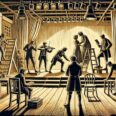
The Los Angeles City Council today approved a Historic-Cultural Monument designation for the 30-year home of master architect Paul Revere Williams, who designed more than 3,000 buildings, including homes in Pasadena, during his nearly six-decade career and was the first African American architect to be a member and fellow of the American Institute of Architects.
Williams designed homes in Pasadena. The Linda Vista Area of West Pasadena has many Spanish Colonial and French Country homes of his design, including many commissioned by business magnates and actors.
Last year, Pasadena Heritage presented a photographic exploration of Williams’ work.
The designation was recommended by the Los Angeles Cultural Heritage Commission on Nov. 4. The home at 1271 W. 35th St. in Jefferson Park was listed for sale on July 5 for $1.6 million and initially was advertised as a “Student Housing Development opportunity … just blocks to the University of Southern California.”
The L.A. Conservancy submitted the application requesting that the Craftsman-style house where Williams lived from 1921 to 1951 be added as a Historic-Cultural Monument, saying that it “illustrates a part of Paul Revere Williams’ life and story that is rarely told or fully understood.”
Adrian Scott Fine of L.A. Conservancy told commissioners that the group’s hope is to attract a preservation-minded buyer instead of a developer.
Following the commission’s vote on Sept. 2 to take up consideration of the house as a Historic-Cultural Monument, the property’s listing was updated to advertise it as a “rare single-family residence, a historic nominated monument, which belonged to the most influential African American architect, Paul Revere Williams.”
The listing price was also lowered from $1.6 million to $1.2 million at the end of September, and then it was removed on Nov. 8, a few days after the Cultural Heritage Commission recommended the property be added to the city’s Historic-Cultural Monument List.
“While this is not architecturally significant … it’s really about the story and his association with this place and what it illustrates about him as a Black man, as a Black architect and his family in terms of where they could live and where they could not,” Fine said.
The Cultural Heritage Commission received hundreds of letters regarding the designation, and several people called in to support the nomination during the meeting on Nov. 4. During the council’s meeting on Sept. 2, one person called in to oppose the property’s nomination, instead recommending that pieces of the home be donated to a museum.
Commissioner Gail Kennard responded saying that the location is more a part of the story than the physical house, given that Williams, who designed homes for celebrities in white neighborhoods, had to live in Jefferson Park, one of the few areas in Los Angeles where Black people were allowed to buy homes.














 0 comments
0 comments


